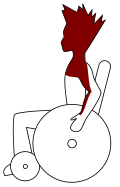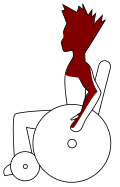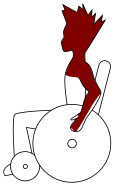Para-alpine skiing classification
Para-alpine skiing classification is the order system for para-Alpine skiing designed to give equal competition between alpine skiers with different types of limited physical powers.[1] The system of ordering are grouped into three general condition of being unable sorts: stand, unable to see and being seated.[2] Group selection is done by International Paralympic Committee AlpineSkiing. Prior to that, several groups dealt with this including the International Sports Organization for the Disabled (ISOD), International Stoke Mandeville Games Federation (ISMWSF), International Blind Sports Federation (IBSA) and Cerebral Palsy International Sports and Recreation Association (CP-ISRA).[3] Some order systems are persons given government by bodies other than International Paralympic Committee Alpine skiing, such as the Special Olympics. The sport is open to all competitors with a no seeing or physical condition of being unable stand. It is not open to people with intellectual disabilities.[4][5]
-
B1 skier who cannot see well
-
B2 skier who cannot see well
-
B3 skier who cannot see well
-
Able to move area of a CP5 classified skier
-
Able to move area of a CP5/CP6 classified skier
-
Able to move area of a CP6/CP7 classified skier
-
Able to move area of a CP7/CP8 classified skier



The first order systems for para-Alpine sking were made in Scandinavia in the 1960s, with early systems designed for skiers with no legs or arms. At the time, necessary things had yet to be done to let skiers with spinal cord wounds ski. The purpose of the early order systems was to be made around use of arms and legs but ended up being a medical order system.[6] At the first Winter Paralympics in 1976, there were two groups in the system of ordering for the sport.[7] By the 1980s, groups had existence for skiers with cerebral palsy.[8] At that time, with inspiration from wheelchair basketball classification, efforts were made to make order more of an able to use better system.[6] Ten groups had existence by the 1980s, and since then, efforts have been made to make better the doing work well of order by making fewer the number of classes so fewer medals can be rewarded.[9][10]
Competition rules for groups use rules made by or are an adjustment from rules by the International Ski Federation.[11] For skiers with seeing problems, guides are used to help the skier down the mountain.[5][11] For standing skiers, different part rules come to a decision about what sort of necessary things is let in competition, such as one long stick, two sticks or no sticks, or one or two skis.[5][11] Seated skiers use a specially designed ski for going over snow quickly called a mono-ski.[11] Skiers are put in a group based on medical, and their body position when they ski. Unable to see skiers are put in order only on a medical.[12]
| Type | What | Equipment |
|---|---|---|
| LW 1 | Twice leg cutting off above the knee, middle to serious cerebral palsy, or equal problem | two narrow wood fixed on feet for going over snow quickly (skis), two outrigger skis |
| LW 2 | ne only leg cutting off above the knee | two skis, two outrigger skis |
| LW 3 | twice leg cutting off below the knee, warm cerebral palsy, or equal impairment | Two skis, two sticks |
| LW 4 | one only leg cutting off below the knee | Two skis, two sticks |
| LW5/7-1 | twice arm cutting off above the angle of arm | Two skis, no sticks |
| LW 5/7-2 | twice arm cutting off, one above and one below the angle of arm | Two skis, no sticks |
| LW 5/7-3 | twice arm cutting off below the angle of arm | Two skis, no sticks |
| LW6/8.1 | one only arm cutting off above the angle of arm | Two skis, one stick |
| LW 6/8.2 | one only arm cutting off below the angle of arm | Two skis, one stick |
| LW9.1 | cutting off or equal impairment of one arm and one leg above the knee | skier can chose |
| LW9.2 | cutting off or equal impairment of one arm and one leg below the knee | skier can chose |
| Type | What |
|---|---|
| LW10.1 | paralysis of the legs and lower half of the body with no upper stomach-related group event and no able to use being seated balance |
| LW 10.2 | paralysis of the legs and lower half of the body with some upper stomach-related group event and no able to use being seated balance |
| LW11 | paralysis of the legs and lower half of the body with equal able to use being seated balance |
| LW12.1 | paralysis of the legs and lower half of the body with some leg purpose, use and good being seated balance |
| LW 12.2 | twice leg cutting off above the knees |
| Type | What |
|---|---|
| B1 | completely unable to see |
| B2 | used-in-seeing acuity of less than 2/60 |
| B3 | used-in-seeing acuity of 2/60 to 6/60 |
References
change- ↑ Alpine Skiing Technical Manual. Salt Lake City, Utah: Salt Lake Organizing Committee. 2002. This is included as an appendix in the media guide on page 19, but it is not published by the APC. Archived from the original on 2016-03-08. Retrieved 2013-05-16.
- ↑ Steadward, Robert D; Peterson, Cynthia (1997). Paralympics : where heroes come. Edmonton: One Shot Holdings Publ. Division. pp. 159–164. ISBN 0968209203. OCLC 716890782.
- ↑ Paralympic winter games 1976-2006 : Ornskoldsvik — Torino. Bon, Germany: International Paralympic Committee. 2006. p. 78. 62307.
- ↑ Joseph P. Winnick (27 October 2010). Adapted Physical Education and Sport. Human Kinetics. pp. 560–568. ISBN 978-0-7360-8918-0. Retrieved 3 October 2012.
- ↑ 5.0 5.1 5.2 Australian team media guide : 2002 Salt Lake City Paralympic Games, March 7-16, 2002. Australia: Australian Paralympic Committee. 2002. 27972. Archived from the original on 8 March 2016. Retrieved 2 October 2012.
- ↑ 6.0 6.1 Paralympic winter games 1976-2006 : Ornskoldsvik — Torino. Bon, Germany: International Paralympic Committee. 2006. p. 82. 62307.
- ↑ Kahrs, Nina; Kroken, Anne Ragnhild (1998). "Classifying Tests in Nordic Cross-Country Sit-Skiing — A Discussion of the %-System in Relation to the Concept of "Fair Player"". In Yabe, Kyonosuke (ed.). Trends and issues in Winter Paralympic sport : proceedings of Winter Paralympic Experts Congress -4th Paralympic Congress — organized by the IPC and NAPOC March 7-8, 1998 Nagano, Japan. Nagano, Japan: Nagano Paralympic Organizing Committee. pp. 67–69.
- ↑ Cerebral Palsy-International Sports and Recreation Association (1983). Classification and sport rules manual (Third ed.). Wolfheze, the Netherlands: CP-ISRA. OCLC 220878468.
- ↑ DePauw, Karen P; Gavron, Susan J (1995). Disability and sport. Champaign, IL: Human Kinetics. p. 120. ISBN 0873228480. OCLC 31710003.
- ↑ Paralympic winter games 1976-2006 : Ornskoldsvik — Torino. Bon, Germany: International Paralympic Committee. 2006. pp. 84–86. 62307.
- ↑ 11.0 11.1 11.2 11.3 Goldman, Judy (2010). "02 Games History and Facts". Australian Paralympic Committee : media guide Vancouver 2010, 12-21 March (PDF). Sydney, Australia: Australian Paralympic Committee. p. 22. Archived from the original (PDF) on 2012-03-31. Retrieved 2013-05-16.
- ↑ Joseph P. Winnick (27 October 2010). Adapted Physical Education and Sport. Human Kinetics. p. 51. ISBN 978-0-7360-8918-0. Retrieved 21 August 2012.






